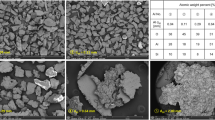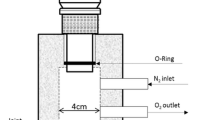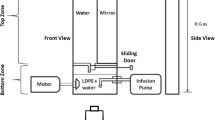Abstract
With more infrastructures being built in high-altitude regions, the impact of low atmospheric pressure on the stability of air bubbles in cementitious materials has aroused extensive attention. However, its influence is still inconclusive since it is difficult to isolate the factor of air pressure and study it. To solve this problem, the study investigated the bubble dynamic evolution in cement paste at standard atmospheric pressure (P = 0.1 MPa) and low atmospheric pressure (LAP = 0.8P, 0.6P, 0.4P, 0.2P) and revealed the mechanism of bubble instability under low atmospheric pressure. We established the bubble dynamic evolution equation in cement paste, computed the real-time bubble radius, resultant force, and critical time at different air pressure by MATLAB software. Results show that the maximum resultant force decreases by 50.0–57.7% when air pressure drops from P to 0.2P; both critical time (\(t\)) and radius increment (\(\Delta R\)) increase with the reduction of air pressure and the increase of initial radius. It indicates that when at 0.2P, the resultant force which inhibits bubble expansion is reduced, the time required to prevent bubble expansion increases by 94–137%, and \(\Delta R\) grows 122–140% larger than that at P, and the bubble is more prone to instability and rupture than that at P. The key to improving bubble stability in low atmospheric pressure is to reduce the initial radius of bubbles and increase the strength of the bubble film. This work firstly discovered the impact of low atmospheric pressure on bubble dynamic evolution in cement paste and proposed a new perspective to explore bubble stability at low atmospheric pressure.
Graphical abstract












Similar content being viewed by others
Data availability
The data will be made avalable if required.
References
Zeng XH, Lan XL, Zhu HS, et al. A review on bubble stability in fresh concrete: mechanisms and main factors. Materials. 2020;13(8):1820. https://doi.org/10.3390/ma13081820.
Lan XL, Zeng XH, Zhu HS, et al. Experimental investigation on fractal characteristics of pores in air-entrained concrete at low atmospheric pressure. Cem Concr Compos. 2022. https://doi.org/10.1016/j.cemconcomp.2022.104509.
He R, Yang Z, Gan VJ, Chen H, Cao D. Mechanism of nano-silica to enhance the robustness and durability of concrete in low air pressure for sustainable civil infrastructures. J Clean Prod. 2021;321: 128783. https://doi.org/10.1016/j.jclepro.2021.128783.
Zeng X, Lan X, Zhu H, Long G, **e Y. Investigation on air-voids structure and compressive strength of concrete at low atmospheric pressure. Cement Concr Compos. 2021;122: 104139. https://doi.org/10.1016/j.cemconcomp.2021.104139.
Li Xuefeng Fu, Zhi WH. Research on design method of air content of antifreeze air-entrained concrete in plateau area. Silicate Bull. 2021;40(08):2600–8. https://doi.org/10.16552/j.cnki.issn1001-1625.2021.08.010.
Fu X, Shen W, Yao T, Hou W. Physical chemistry (Volume 1). 4th ed. Bei**g: Higher Education Press; 2005.
Ke GJ, Tian B, Li XF, et al. Research on and concrete structures destroyed along South Line of Sichuan-Tibet Highway. Ind Constr. 2015;45:58–65.
Liu X. Deterioration mechanism of concrete in plateau environment and the influence of construction quality on it. Southwest Jiaotong University. (Master’s Thesis). 2017.
Li XF. Anti-frost Design Method and Preventive Measures for Concrete Structure in the Qinghai-Tibet Plateau. Southeast University. (Doctoral dissertation). 2015.
Liu Xu, **n C, Bo T, Lihui Li, Yong Ge. Research progress on the properties of cement concrete under low pressure environment. J Silicate. 2021;49(08):1743–52. https://doi.org/10.14062/j.issn.0454-5648.20200922.
Shi Y, Yang HQ, Zhou SH, et al. Effect of atmospheric pressure on performance of AEA and air entraining concrete. Adv Mater Sci Eng. 2018;10:1–7. https://doi.org/10.1155/2018/6528412.
He R, Wang T, Chen HX, et al. Impact of Ferlinghetti plateau’s climate on strength and permeability of concrete China. J Highw Transp. 2020;33(7):29–41. https://doi.org/10.19721/j.cnki.1001-7372.2020.07.003.
Kun Z, Hengzhou W, Yufu X, et al. Study on the influence of fluid physical properties on cavitation bubble collapse process. J Hefei Univ Technol (Natural Science Edition). 2011;34(09):1295–7+1312.
Lingxin Z, Qin Y, Xueming S. Theoretical and numerical study of bubble collapse in water. Hydrodyn Res Progress A. 2012;27(01):68–73.
Pan LM, Zhang WZ, Chen DQ, et al. Effect of additional inertial force on bubble breakup. Nucl Power Eng. 2011;32(04):37–41 (0258-0926(2011)04-0037-05).
Rosen. Surfactants and interfacial phenomena. 4th ed. Amsterdam: Colloids & Surfaces; 2012.
Li SY, Wu RH, Wang XY, et al. Effect of environmental pressure on cavitation pulsation characteristics. Acta Photon Sin. 2016;45(03):12–6. https://doi.org/10.3788/gzxb20164503.0314002.
Shuai Li, Longquan S, Arman Z. Dynamic behavior of rising bubble. J Phys. 2014;63(18):291–303.
Oratis AT, Bush JWM, Stone HA, et al. A new wrinkle on liquid sheets: turning the mechanism of viscous bubble collapse upside down. Science. 2020;369(6504):685–8.
Yang C, **ngrong Z, Yanbo S, et al. Measurement techniques of foam performance and influence factors of foam stability. China Min. 2014;23(S2):230–4.
Mielenz RC, Wolkodoff VE, Backstrom JS. Origin, evolution, and effects of the air void system in concrete: Part 1: entrained air in unhardened concrete. ACI J Proc. 1958;55:5–122.
Shengyong Li, **aoyu W, Jiang’an W, et al. Experimental investment of influence of ambient pressure on properties of laser induced cavity bubble collapse sound waves. Infrared Laser Eng. 2015;44(03):879–83.
Han S, Zhu H. Theoretical and numerical studies on the collapse of single and double-bubble system in water. Int J Numer Methods Fluids. 2020;93(3):527–42.
Li Y, Wang Z, Wang L. Effect of low pressure on bubble generation and development of air entraining agent solution. Concrete. 2019;8:144–8.
Nan C, Zhihong W, Youquan L, et al. Research on foaming ability and foam stability of foaming agent at the temperature and pressure. Pet Nat Gas Chem. 2017;46(05):65–8.
Zeng X, Lan X, Zhu H, et al. Using stirring power curves to investigate the air-entrainment and mechanical properties of cement mortar at low air pressure. Constr Build Mater. 2023;378:131142. https://doi.org/10.1016/j.conbuildmat.2023.131142.
Li LH, Chen X, Tian B, et al. Effect of atmospheric pressure on air-entraining performance of air-entraining agent of concrete. J Build Mater. 2021;24(04):866–73. https://doi.org/10.3969/j.issn.1007-9629.2021.04.026.
Liu X. Effect of low atmospheric pressure on air entraining effectiveness and pore structure of concrete. Harbin: Harbin Institute of Technology. (Master’s dissertation). 2020.
Zuo S, Yuan Q, Huang T. Microstructural changes of young cement paste due to moisture transfer at low air pressures. Cem Concr Res. 2023. https://doi.org/10.1016/J.CEMCONRES.2022.107061.
Shiwen, M. (2013) Study on dynamic behavior of ultrasonic cavitating bubbles. Shaanxi Normal University, (Master thesis)
Lan X, Zhu H, Zeng X, Long G, **e Y. How nano-bubble water and nano-silica affect the air-voids characteristics and freeze-thaw resistance of air-entrained cementitious materials at low atmospheric pressure. J Build Eng. 2023;69: 106179. https://doi.org/10.1016/j.jobe.2023.106179.
Lan X, Zhu H, Zeng X, Long G, **e Y. Surface tension of cementitious pore solutions at low atmospheric pressure: an experimental exploration. Cem Concr Compos. 2023;145:105309.
Mairong Xu, Chengyun L. The change of radius and velocity of the rising bubble in water. Coll Phys. 2008;11:14–7. https://doi.org/10.16854/j.cnki.1000-0712.2008.11.005.
Natalie B, Cosima S. A disjoining pressure study of foam films stabilized by mixtures of nonionic and ionic surfactants. Langmuir. 2007;23(10):5315–23.
Acknowledgements
The authors appreciate the financial support provided by the National Natural Science Foundation of China (Grant number 52078490) and Fundamental Research Funds for Central Universities of the Central South University (Grant number 502802002).
Author information
Authors and Affiliations
Contributions
Xuli Lan: Writing-Original draft, Methodology, Investigation. XZ: Supervision, Funding acquisition. HZ: Investigation. G-c T: Validation. GL: Validation. ZT: Validation. YX: Resources.
Corresponding author
Ethics declarations
Conflict of interest
The authors declare that they have no known competing financial interests or personal relationships that could have appeared to influence the work reported in this paper.
Ethical approval
This research was done according to ethical standards.
Additional information
Publisher's Note
Springer Nature remains neutral with regard to jurisdictional claims in published maps and institutional affiliations.
Rights and permissions
Springer Nature or its licensor (e.g. a society or other partner) holds exclusive rights to this article under a publishing agreement with the author(s) or other rightsholder(s); author self-archiving of the accepted manuscript version of this article is solely governed by the terms of such publishing agreement and applicable law.
About this article
Cite this article
Lan, Xl., Zeng, Xh., Zhu, Hs. et al. Investigation on the impact of low atmospheric pressure on bubble stability in cement-based materials. Archiv.Civ.Mech.Eng 24, 33 (2024). https://doi.org/10.1007/s43452-023-00824-2
Received:
Revised:
Accepted:
Published:
DOI: https://doi.org/10.1007/s43452-023-00824-2




